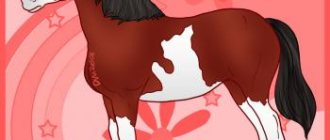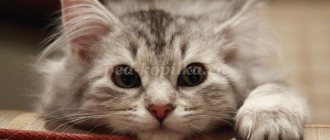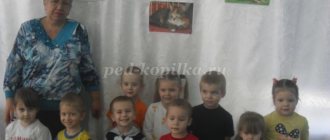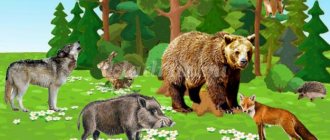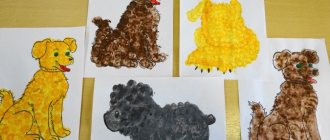Cognition lesson “Pets”. Middle group
Cognition lesson in the middle group “Pets” Author: teacher of MBDOU “DS KV “Fairy Tale” Urengoy Degtyarenko Tatyana Vasilievna.
Goal: clarification, expansion and activation of the dictionary on the topic “Pets”; Objectives: - to consolidate the skill of correctly agreeing adjectives with nouns; - to develop the ability to use prepositions “on”, “under”, “for”, “in”, “from” in speech; — consolidate the skill of composing a common sentence using prepositional-case constructions; — to train children in composing complex sentences that include prepositional-case constructions; - develop visual and auditory perception; — develop fine motor skills and spatial orientation; — automate the supplied sounds; - cultivate a caring attitude towards pets. Equipment: toys (cat and kittens), demonstration pictures of pets, magnetic cards for the game “Friendly Family”.
Progress of the lesson
1. Organizational moment Children stand in a circle, holding hands:
We, girls and boys, are not used to being discouraged.
We love to listen to books and, of course, play! 2. Statement of the topic and purpose of the lesson. 3. Didactic game “Recognize by Voice” The teacher imitates the cry of different domestic animals, invites children to recognize these animals and answer on behalf of the cubs of these animals. 4. Finger game “Cat” by E.B. Chistyakova
Look, on the window - hands like a house above your head.
Our cat appeared -
smooth movements of her hands in front of her chest
. Ears are sharp, cheeks are thick -
all the fingers take turns saying hello.
Eyes are cunning, paws are fast.
with thumbs 5. Game “Hide and Seek” The teacher invites the children to find the kittens of the cat Muska (the kittens are hidden in different parts of the group). Children:
- I found this kitten on a chair (under the table, on the window, in the closet, on the shelf, etc.)
6. Didactic game “How are they alike?” - Choose a kitten that looks like its mother and tell us what the similarities are. Possible answers for children: - This kitten looks like its mother. His ears are sharp, like Muska's. — This kitten looks like its mother. Muska has a white muzzle, and the kitten also has a white muzzle. — This kitten looks like its mother with a red fur coat. 7. Physical education minute Folk outdoor game “Cat and Mouse” 8. Didactic game “Friendly Family” The teacher displays a picture of a pet (father) and invites the children to find the mother and baby from this family. Answer form: - The bull and the cow have a small calf. — The goat and the goat have a small kid. — The ram and the ewe have a little lamb. — The cat and the cat have a small kitten. 9. Didactic game “Naughty Girls” The teacher invites the children to close their eyes, changes the animals in their families, invites the children to tell who ran away from whom and return the naughty ones to their place.
Expected answers from the children: -
The kitten ran away from the cat and the cat, and the calf - from the bull and the cow. 10. Summary of the lesson. The teacher invites the children to talk about what they liked during the lesson and thanks them for their activity and knowledge. List of used literature: 1. Shchetinin M. Breathing gymnastics A.N. Strelnikova. – M.: . Metaphor. 2007.
We recommend watching:
Summary of a lesson on speech development in the middle group on the topic: “Ukraine is my native land” Summary of the educational situation in the middle group Summary of a lesson for children of middle preschool age Summary of an open lesson on ecology in the middle group
Similar articles:
Summary of educational activities on cognitive development for the middle group
Summary of GCD for kindergarten on the topic: “Human body”
Summary of GCD for preschool educational institutions on the topic: “I am a girl, I am a boy”
GCD summary for kindergarten on the topic: “I’m growing”
Summary of GCD in a preschool educational institution on the topic: “Our language”
Summary of a lesson in the middle group using ICT on the topic: Pets
Pets.
Lesson summary for children of middle preschool age Description of the material: I bring to your attention a lesson summary for children of the middle subgroup (4-5 years old) on the topic “Pets.”
This material will be useful for teachers of the middle group or teachers of different age groups. The outline of the educational lesson is aimed at developing knowledge about pets, developing a friendly attitude and a desire to care for them. Summary of a lesson on cognitive development on the topic “Pets”
Purpose: To expand children’s understanding of domestic animals (about what they look like, what they eat, how they are taken care of and what benefits they bring to humans. Program content: 1. To consolidate children’s understanding of domestic animals animals; 2. To develop children’s understanding of the special caring attitude of people towards animals; 3. To consolidate knowledge about the external signs of domestic animals, where they live, what they eat; 4. To instill a love for animals; 5. To develop the ability to listen to an interlocutor and express one’s opinion on an established topic ; 6. Expand vocabulary Materials: • Wooden model with pets “My Compound”; • Toys in the form of pets; • Computer with a presentation “Pets”; • Landscape sheets, pencils for drawing;
Progress of classes:
Place a wooden model with pets and toys on the table in front of the children.
1 Introductory part: Educator: Children, today we will talk about pets. (Slide 1) Please tell me what you already know about them? (children talk about the animals they know) Educator: Well done, guys. Let's play with you now? I will ask riddles, and the answers will appear on the computer screen. The thick grasses are braided, the meadows are curled, and I myself am all curly, even with a curl of the horn (slide 2: Ram) Who sings with his mouth closed? He opens his mouth and doesn’t sing. Walks with silent steps, is not afraid of the dark. And although he is wearing a lush fur coat, he loves to warm himself by the stove. (slide 3: Cat) A faithful friend to man, I sensitively hear every sound. I have an excellent sense of smell, a keen eye and keen hearing. (slide 4: Dog) The nose is a round snout, and the perky tail is a hook. Mom is a pig, dad is a pig. He is their favorite son. (slide 5: Piglet) I’ll tell you: “Me-me-me! Get ready for winter! Quickly cut my wool and knit your own socks!” (slide 6: Goat) Red dairy chews day and chews night: After all, grass is not so easy to turn into milk. (slide 7: Cow) Not a plowman, not a blacksmith, not a carpenter, But the first worker in the village (slide 8: Horse) (listening to the children’s answers, asking leading questions if necessary) 2 Main part: Educator: Well done children, they were able to guess all our guests. Let's once again remember the names of the animals that came to visit us today (ram, cat, dog, pig, goat, cow, horse) - How can you call all these animals in one word? (pets) -Why do we call them that? (Because a person takes care of them) -What is the name of the house in which these animals live? (slide 9: Animal Farm) Educator: Guys, let's play the game “Name the baby pets”? I will show the slides, and you will name the young domestic animals. ( Slide show from 10 to 15 ) Educator: - Tell me, what do domestic animals eat? (Children give, ask leading questions if necessary) - What benefits do they bring to humans? (wool) , meat, leather, milk, dogs guard houses, cats catch mice) Educator: Guys, let's draw a pet? Please look at the screen, what animal do you see? (slide 16: Cat, dog) -And now, we’ll try to draw the same cat or dog. Go to the tables. (Children sit at the tables and draw the chosen animal) Educator: What beautiful drawings you have made! Now, let's do the finger gymnastics “The cat sharpens its claws.” “If a cat sharpens its claws (bend and straighten its fingertips strongly), it will rain outside the window.” (Gymnastics are being carried out) Educator: Now I want to invite you to play the game “Guess Who”. I will turn on the sounds with which animals communicate, and after listening carefully, you will name these animals. (sound tracks: barking dog, mooing cow, purring cat, bleating goat, neighing horse) (Children give their answers) Educator: Well done children, you recognized the voices of our guests. Let's tell you how we know how to affectionately call our pets. Exercise “Name it affectionately” : Cat. What will you call her affectionately? (kitty) Dog? (doggie) Cow? (lady) Horse? (horse) Sheep? (lamb). Educator: So, let's summarize our lesson, what did we talk about today? Why do people have pets? How are they cared for? (Children answer, complementing each other’s answers) Educate: Well done, you learned and remembered a lot for yourself today.
Thanks to all! Presentation on the topic: Getting to know pets
We recommend watching:
Summary of a lesson in the middle group on the works of Marshak Notes of the GCD in the middle group “Help the Cockerel” Summary of the GCD in the middle group on the topic: “Who lives in the little house?” Summary of a design lesson in the middle group "Tumbler"
Similar articles:
Math lesson “Rectangle” in the middle group of kindergarten
